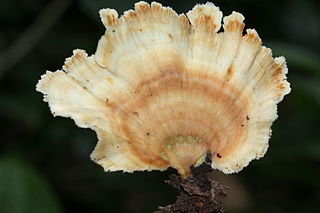Related Research Articles

Oxyporus is a genus of polypore fungi in the family Schizoporaceae. An individual family Oxyporaceae was described for the genus. A number of species in this genus are plant pathogens, causing a white rot. The genus is widely distributed.

Phlebiopsis is a genus of poroid crust fungi in the family Phanerochaetaceae. The genus contains 11 species, which collectively have a widespread distribution. The genome sequence of the type species, Phlebiopsis gigantea, was published in 2014.

Ceriporia is a widely distributed genus of crust fungi.
Australicium is a genus of two species of crust fungi in the family Phanerochaetaceae. The genus was circumscribed by mycologists Kurt Hjortstam and Leif Ryvarden in 2002 to contain the type species, A. singulare, which is found in New Zealand. The Venezuelan species A. cylindrosporum was added to the genus in 2005.

Antrodiella is a genus of fungi in the family Steccherinaceae of the order Polyporales.

Hydnophlebia is a genus of five species of toothed crust fungi in the family Meruliaceae. All species are wood-decay fungi that cause a white rot.

Diplomitoporus is a genus of fungi in the family Polyporaceae. The Dictionary of the Fungi estimated the widespread genus to contain 11 species; since then, the genus has grown with the additional of several newly described species, and some transfers from other genera. Diplomitoporus has been described as a wastebasket taxon, containing "species that share common macroscopic and microscopic characteristics, but are not necessarily related."

Flabellophora is a genus of poroid fungi in the family Steccherinaceae. The genus was circumscribed by New Zealand-based mycologist Gordon Herriot Cunningham 1965. Most species in the genus were described by E. J. H. Corner in 1987.

Nigroporus is a genus of poroid fungi in the family Steccherinaceae. The genus was circumscribed by American mycologist William Alphonso Murrill in 1905. Nigroporus has a pantropical distribution. The genus name combines the Latin word niger ("black") with the Ancient Greek word πόρος ("pore").

Skeletocutis is a genus of about 40 species of poroid fungi in the family Polyporaceae. The genus has a cosmopolitan distribution, although most species are found in the Northern Hemisphere. Skeletocutis causes a white rot in a diverse array of woody substrates. Their fruit bodies grow as a crust on the surface of the decaying wood. Sometimes the edges of the crust are turned outward to form rudimentary bracket-like caps.
Tinctoporellus is a genus of fungi in the family Polyporaceae. Species in the genus produce crust-like fruit bodies with pore-containing surfaces. The type species, T. epimiltinus, grows on the wood of angiosperms and is widespread in distribution. Tinctoporellus was circumscribed by Norwegian mycologist Leif Ryvarden in 1979. He suggested that Antrodia was closely related based on morphological similarities.
Skeletocutis microcarpa is a species of poroid fungus in the family Polyporaceae that is found in Venezuela. It was reported as a new species by mycologists Leif Ryvarden and Teresa Iturriaga. The type collection was made in January 1997, in Yutajé, where it was found growing on the bark of a living tree. The fruit bodies of this fungus are in the form of small brown caps measuring up to 8 mm wide and long by 4 mm thick. Its spores are smooth, ellipsoid, hyaline, and measure 3–3.3 by 2 μm.
Nigroporus macroporus is a species of poroid fungus in the family Steccherinaceae. It was described as new to science in 2003 by mycologists Leif Ryvarden and Teresa Iturriaga. Found in Venezuela and Brazil, it is a wood-decay fungus that causes a white rot in the hardwood Dimorphandra macrostachya.
Metuloidea cinnamomea is a species of tooth fungus in the family Steccherinaceae. Found in the Andes region of Venezuela, it was initially described in 2010 by Teresa Iturriaga and Leif Ryvarden as a species of Antrodiella. Otto Miettinen and Ryvarden transferred it to the newly created genus Metuloidea in 2016.
Rigidoporus nevadensis is a species of polypore fungus in the family Meripilaceae. Found in the Andes region of Venezuela, it was described as a new species in 2010 by mycologists Teresa Iturriaga and Leif Ryvarden.
Diplomitoporus microsporus is a species of poroid fungus in the family Polyporaceae. Found in the Andes region of Venezuela, it was described as a new species in 2010 by mycologists Teresa Iturriaga and Leif Ryvarden.
Trulla dentipora is a neotropical polypore fungus in the family Steccherinaceae, and the type species of the genus Trulla. Characteristics of this species are the irregularly shaped pores with jagged or teeth-like edges, and the sausage-shaped spores. Found in Venezuela, the fungus was originally described by mycologists Leif Ryvarden and Teresa Iturriaga in 2004 as a species of Antrodiella. The type was collected in Henri Pittier National Park, where it was found growing on a hardwood log. Ryvarden and Otto Miettinen transferred the fungus to the newly created Trulla in 2016.
Ceriporia amazonica is a species of crust fungus in the family Irpicaceae. Found in Brazil, it was described as new to science in 2014. The fungus is characterized by its salmon-coloured pore surface with angular pores numbering 1–3 per millimetre, and small ellipsoid spores that are among the smallest in genus Ceriporia. The type locality is Amapá National Forest, in the Brazilian Amazon, for which the species is named.
Skeletocutis polyporicola is a species of poroid crust fungus in the family Polyporaceae that is found in South America. It was described as a new species in 2011 by mycologists Leif Ryvarden and Teresa Iturriaga. The holotype, collected in Venezuela, was found growing on a dead fruit body of Fomitopsis supina.
References
- ↑ Ryvarden, L.; Iturriaga, T. (2010). "Studies in Neotropical polypores 29. Some new and interesting species from the Andes region in Venezuela". Synopsis Fungorum. 27: 78–91.
| | This Polyporales-related article is a stub. You can help Wikipedia by expanding it. |